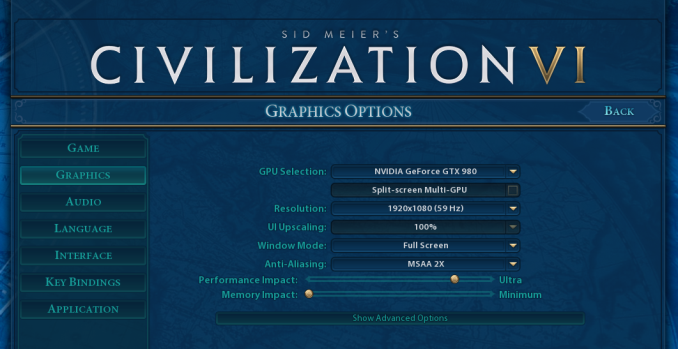Retesting AMD Ryzen Threadripper’s Game Mode: Halving Cores for More Performance
by Ian Cutress on August 17, 2017 12:01 PM ESTCivilization 6
First up in our CPU gaming tests is Civilization 6. Originally penned by Sid Meier and his team, the Civ series of turn-based strategy games are a cult classic, and many an excuse for an all-nighter trying to get Gandhi to declare war on you due to an integer overflow. Truth be told I never actually played the first version, but every edition from the second to the sixth, including the fourth as voiced by the late Leonard Nimoy, it a game that is easy to pick up, but hard to master.
Benchmarking Civilization has always been somewhat of an oxymoron – for a turn based strategy game, the frame rate is not necessarily the important thing here and even in the right mood, something as low as 5 frames per second can be enough. With Civilization 6 however, Firaxis went hardcore on visual fidelity, trying to pull you into the game. As a result, Civilization can taxing on graphics and CPUs as we crank up the details, especially in DirectX 12.
Perhaps a more poignant benchmark would be during the late game, when in the older versions of Civilization it could take 20 minutes to cycle around the AI players before the human regained control. The new version of Civilization has an integrated ‘AI Benchmark’, although it is not currently part of our benchmark portfolio yet, due to technical reasons which we are trying to solve. Instead, we run the graphics test, which provides an example of a mid-game setup at our settings.
At both 1920x1080 and 4K resolutions, we run the same settings. Civilization 6 has sliders for MSAA, Performance Impact and Memory Impact. The latter two refer to detail and texture size respectively, and are rated between 0 (lowest) to 5 (extreme). We run our Civ6 benchmark in position four for performance (ultra) and 0 on memory, with MSAA set to 2x.
For reviews where we include 8K and 16K benchmarks (Civ6 allows us to benchmark extreme resolutions on any monitor) on our GTX 1080, we run the 8K tests similar to the 4K tests, but the 16K tests are set to the lowest option for Performance.
All of our benchmark results can also be found in our benchmark engine, Bench.
We tested both of the 1950X and the 1920X at their default settings, as well as the 1950X in Game Mode as shown by 1950X-G.
MSI GTX 1080 Gaming 8G Performance
1080p



4K



8K



16K



ASUS GTX 1060 Strix 6G Performance

1080p



4K



Sapphire Nitro R9 Fury 4G Performance

1080p



4K



Sapphire Nitro RX 480 8G Performance

1080p



4K
















104 Comments
View All Comments
peevee - Friday, August 18, 2017 - link
Compilation scales even on multi-CPU machines. With much higher communication latencies.In general, compilers running in parallel on MSVC (with MSBuild) run in different processes, they don't write into each other's address spaces and so do not need to communicate at all.
Quit making excuses. You are doing something wrong. I am doing development for multi-CPU machines and ON multi-CPU machines for a very long time. YOU are doing something wrong.
peevee - Friday, August 18, 2017 - link
BTW, when you enable NUMA on TR, does Windows 10 recognize it as one CPU group or 2?gzunk - Saturday, August 19, 2017 - link
It recognizes it as two NUMA nodes.Alexey291 - Saturday, September 2, 2017 - link
They aren't going to do anything.All their 'scientific benchmarking' is running the same macro again and again on different hardware setups.
What you are suggesting requires actual work and thought.
Arbie - Thursday, August 17, 2017 - link
As noted by edzieba, the correct phrase (and I'm sure it has a very British heritage) is "The proof of the pudding is in the eating".Another phrase needing repair: "multithreaded tests were almost halved to the 1950X". Was this meant to be something like "multithreaded tests were almost half of those in Creator mode" (?).
Technically, of course, your articles are really well-done; thanks for all of them.
fanofanand - Thursday, August 17, 2017 - link
Thank you for listening to the readers and re-testing this, Ian!ddriver - Thursday, August 17, 2017 - link
To sum it up - "game mode" is moronic. It is moronic for amd to push it, and to push TR as a gaming platform, which is clearly neither its peak, nor even its strong point. It is even more moronic for people to spend more than double the money just to have half of the CPU disabled, and still get worse performance than a ryzen chip.TR is great for prosumers, and represents a tremendous value and performance at a whole new level of affordability. It will do for games if you are a prosumer who occasionally games, but if you are a gamer it makes zero sense. Having AMD push it as a gaming platform only gives "people" the excuse to whine how bad it is at it.
Also, I cannot shake the feeling there should be a better way to limit scheduling to half the chip for games without having to disable the rest, so it is still usable to the rest of the system.
Gothmoth - Thursday, August 17, 2017 - link
first coders should do their job.. that is the main problem today. lazy and uncompetent coders.eriohl - Thursday, August 17, 2017 - link
Of course you could limit thread scheduling on software level. But it seems to me that there is a perfectly reasonable explanation why Microsoft and the game developers haven't been spending much time optimizing for running games on systems with NUMA.HomeworldFound - Thursday, August 17, 2017 - link
You can't call a coder that doesn't anticipate a 16 core 32 thread CPU lazy. The word is incompetent btw. I'd like to see you make a game worth millions of dollars and account for this processor, heck any processor with more than six cores.